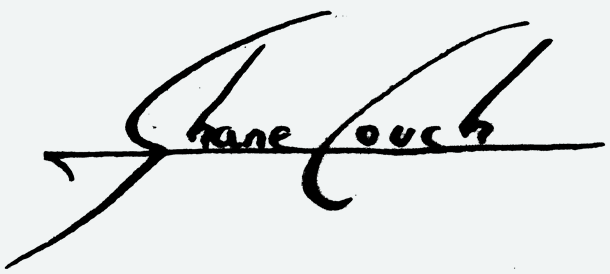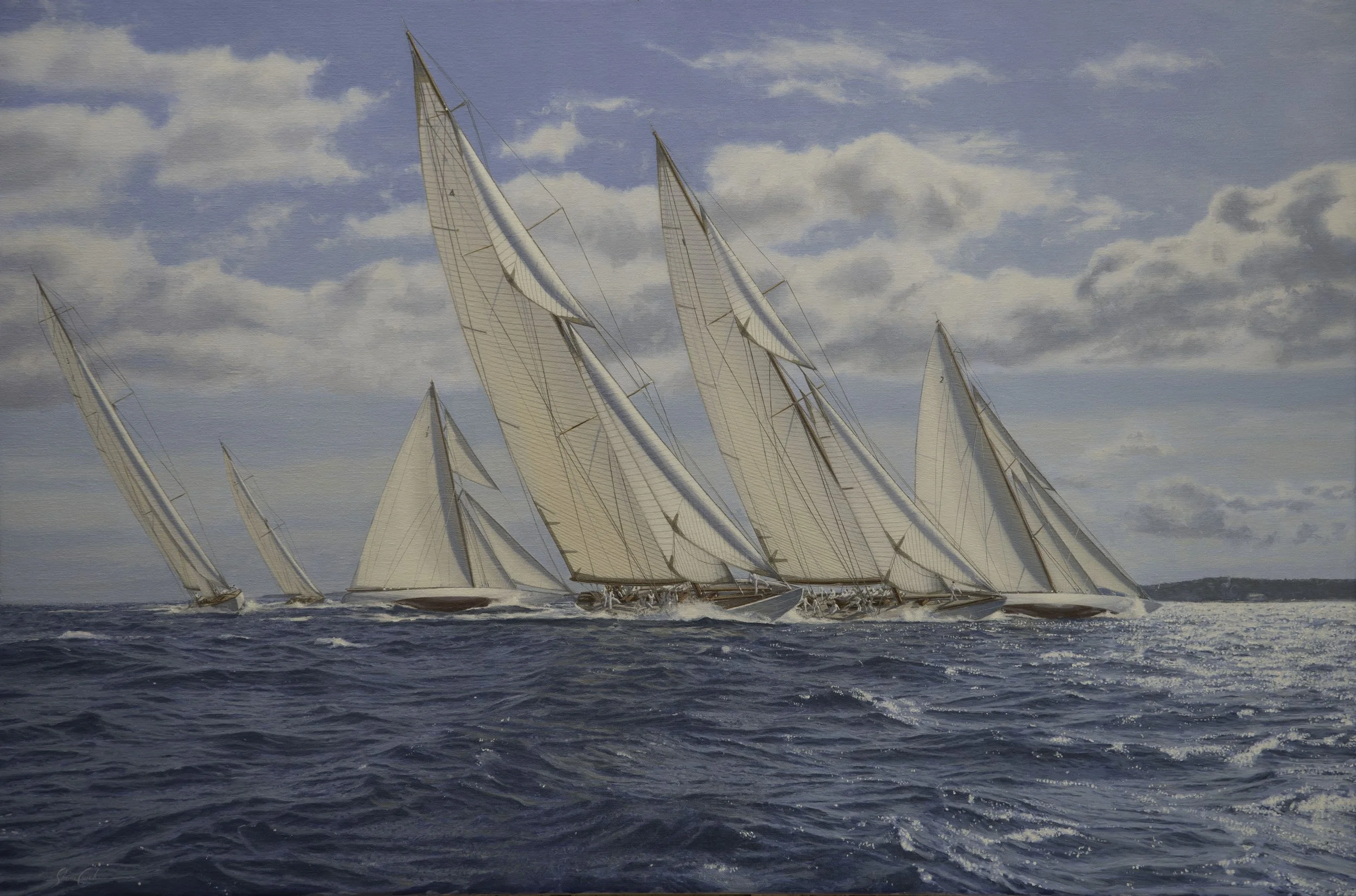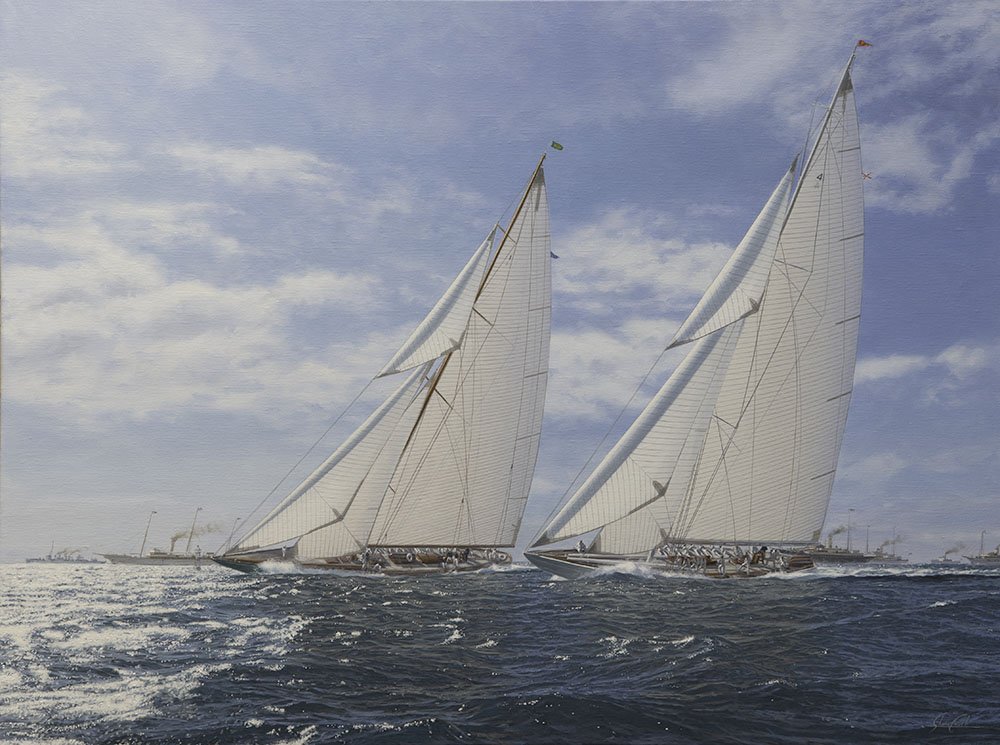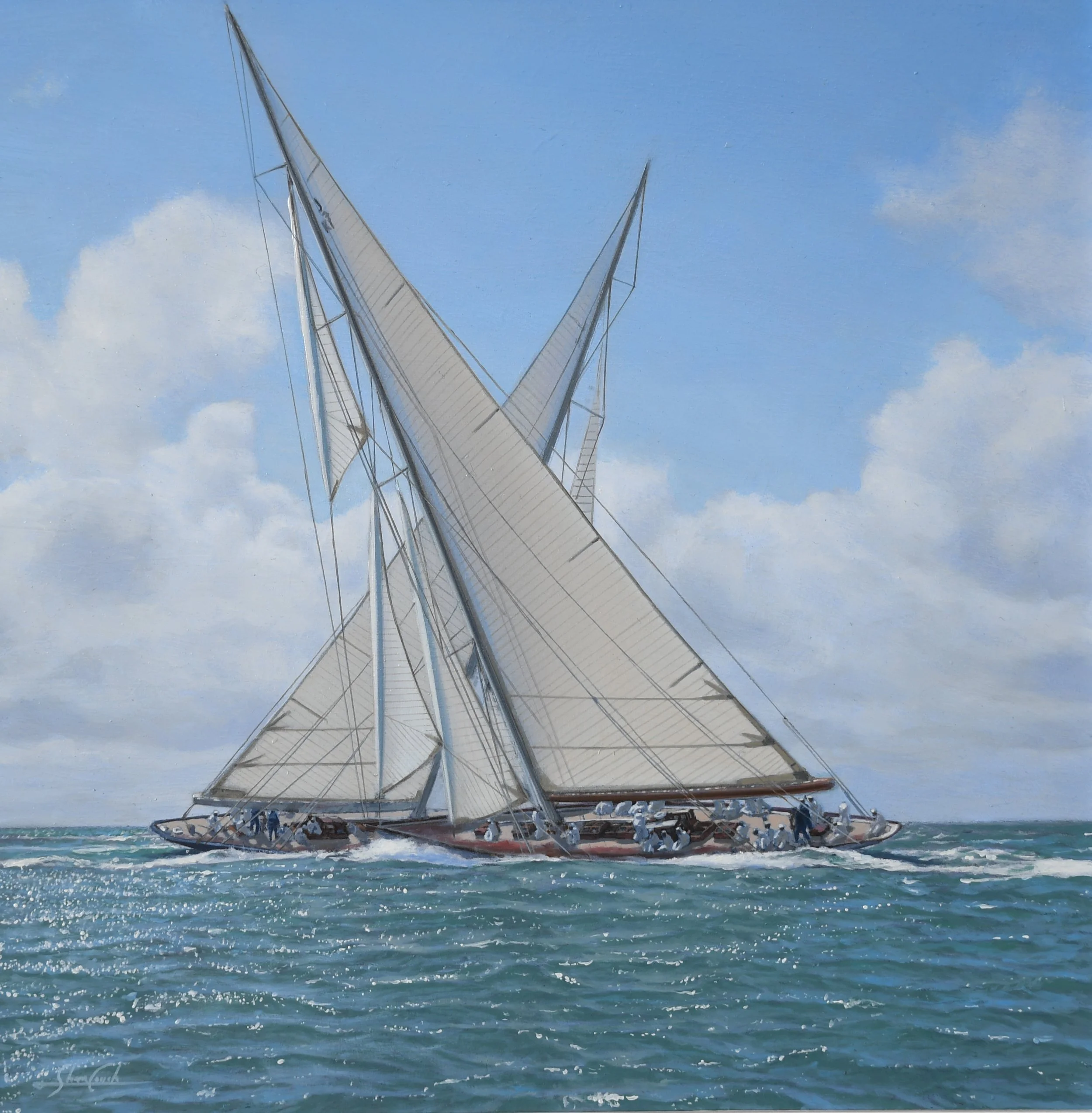History of the J Class
By Shane Couch
In 1930 Sir Thomas Lipton was ready to make his 5th and final challenge for the America’s Cup with his Shamrock V. Designed by Charles E Nicholson England foremost yacht designer, the new yacht was to be built to the J Class, which was part of the Universal Rule. The Universal Rule was introduced to help produce stronger more seaworthy yachts than those that had raced for the Americas Cup prior to the first world war. Shamrock V was also Bermudan rigged, a rig that had become popular in the 1920s with the greater understanding of aerodynamics. Though the J class yachts where of a similar size on the waterline to the older pre-war boats they were driven by only half the sail area, giving the respective designers many factors to consider in their new designs. What they came up with are widely regarded as the most iconic and arguably the most beautiful class of yachts ever built.
The newly built Shamrock V quickly proved herself a great success winning her initial races which included some unofficial trial races against Cambria and Lulworth. Accordingly, when she left for America hopes were high that she could bring back the Cup.
To meet the 1930 challenge of Sir Thomas Lipton four new boats were built as potential defenders. All 4 new boats represented their designer’s different interpretations to the Universal rule.
Enterprise was the first and smallest of the new boats in the water and was quickly undergoing initial trials against the two older boats Cup boats of 1920, Resolute and Vanitie. Both the old boats had been raced throughout the 1920s and now were converted to race in the new J class though their light construction barred them from competing for the right to defend. Having the old boats to race against gave a good gauge as to the relative strengths and weaknesses of the new boats. During May Enterprise repeatedly defeated the older two boat by a good margin proving the advances made in design.
The four new Cup boats competed for the first time in a series of special races on Long Island Sound. Enterprise was joined first by Weetamoe and Whirlwind. Weetamoe designed by Clinton Crane was the narrowest and with a graceful sheer was considered the most beautiful of the new boats. Whirlwind designed by Francis Herreshoff the son of the famous Nat Herreshoff was the longest and most radicle of the new boats.
Yankee the widest of the new boats was designed by Frank Paine for a Boston syndicate joined the other cup boats on the last day of the special races on Long Island.
Enterprise and Weetamoe head the fleet during the Long island series. Oil on canvas 40x60 inches by Shane Couch
Birth of the J Class . All 4 new J Class boats and the older Vanitie and Resolute compete on Long Island Sound . Oil on canvas by Shane Couch 24x36inch
After the Long Island series, the boats moved to Newport competing in races organised by Eastern Yacht Club before the boats were paired of for the observation races in July.
Going into the New York Yacht Club NYYC Cruise in August Weetamoe was the front runner with Enterprise a close second. Both boats were proving very good light weather boats, the prevailing conditions at the time. Yankee was proving best in heavy weather while Whirlwind with all her innovations was proving difficult to control and too large for the prevailing light breezes. Throughout the season Enterprises syndicate leader and Captain Harold Vanderbilt were slowly refining his boat race by race making small improvements here and there including a new lightweight Duralumin mast and park avenue bending boom.
Going into the official trials the margin between the two favourites was very small. When Enterprise defeated Weetamoe in two straight races the first in light weather and the second in heavy weather she was selected to defend the Cup. In the second race Enterprise broke Columbia’s 1901 course record.
In the Cup races of that year Enterprise decisively beat Shamrock V by 4 races to 0.
Enterprise leads Shamrock at the start of race 1. Oil on canvas by Shane Couch 30x40inches
Race 3 start Oil on canvas by ShaneCouch 30x40 inches
Shamrock with her heavy wooden spars lack of winches and crew that was run on old aristocratic traditions was shown to be hopelessly outdated when compared with Enterprises many technological innovations and crew organised along the lines of skill and merit
With Sir Thomas Lipton’s 5th challenge vanquished Enterprise and Whirlwind were laid up at Herreshoff’s yard in Bristol and Yankee at Lawleys in Boston. Only Weetamoe was kept in constant commission for the 1931,32 and 33 seasons frequently racing the older Vanitie which was also kept racing in her new J Class Rig. These two boats racing as they did together were critical in the developments in the class prior to the 1934 challenge from Sir T.O.M Sopwith.
On the death of Sir Thomas Lipton, Shamrock V had been sold to Sir T.O.M Sopwith. Sopwith was an aircraft manufacturer and a well known 12m sailor. During the 1931 and 32 seasons Shamrock dominated the British big class yachting circuit frequently racing the Kings Britannia, the schooner Westward and both the 28m Astra and Candida amongst others.
In 1933 Shamrock was joined by a brand-new J class yacht built for Bill Stephenson the head of Woolworths. It was rumoured that if the new boat Velsheda as she was called was to prove a success she may challenge for the America’s Cup. She did indeed prove a great success dominating the British big class of 1933.
In 1934 a new challenge was received by the NYYC but not from the owner of Velsheda but from Sir T.O.M Sopwith. Sopwith had commissioned Charles Nicholson the designer of both Shamrock and Velsheda to build a new J class yacht specifically to challenge for the Americas Cup. In his challenge of that year Sopwith reserved the right to substitute Velsheda for the new boat Endeavour if Velsheda proved the faster of the two. During the early season of 1934 and in a series of special races against Velsheda Endeavour clearly demonstrated her superiority over the older boat.
Endeavour and Velsheda battle it out off the Isle of Wight. Oil on panel by Shane Couch 12x12 inches
Critically on the eve of departure for America Endeavours finely trained crew went on strike for higher wages. Many of the crew were quickly replaced by highly competent Corinthian amateurs most of whom however had never raced a J boat, never mind taken orders as deck hands.
When news of the new challenge was received the NYYC looked at what yacht could meet the new challenger, the old defender Enterprise was ruled out due to numerous rule changes including a minimum mast weight, internal fittings, and the removal of winches from below decks. Whirlwind was not considered but Yankee was drastically modified with the addition of a new bow by her Boston syndicate and would compete for the right to defend. Unsure that the two older boats Weetamoe and Yankee would prove equal to the task the NYYC turned to Enterprise’s designer Stirling Burgess for a new boat, fortunately he had prepared a new design a few years earlier when it was believed Sir Thomas Lipton was about to make a new challenge, the new design was quickly dusted off and updated and a new boat Rainbow built to his lines.
The J class of 1934 looked different to those of 1930 principally due to a rule that limited the hight of the foretriangle leading to the introduction of the double head rig. This rig along with the new parachute spinnaker had been pioneered by both Vanitie and Weetamoe during the intervening years.
During the early preliminary and observation races held in June and July Weetamoe which had also undergone modifications to her keel proved unsuccessful but Yankee from the very beginning was proving a great success, race after race she defeated the new boat Rainbow and quickly proved herself a clear favourite.
Yankee leads the fleet during NYYC Run to Newport oil on canvas by Shane Couch 60x60 inches
It was during the NYYC annual cruise on the eve of the defender selection trials that Harold Vanderbilt head of Rainbows syndicate made a bold decision to add 7 tons of ballast to Rainbow, in a sink or swim remedy. The difference in Rainbows performance was remarkable administering her first victories over Yankee on the final runs of the annual cruise.
The two boats therefore went into the final battle for selection with the scales well balanced, in a remarkable series of races Rainbow came through the victor by winning the final selection trial by just 1 second.
Battle for selection Rainbow vs Yankee oil on Canvas by Shane Couch 60x60 inches
The Americas Cup races of 1934 were to prove one of the most memorable and controversial contests of the cup’s long history, Remarkably Endeavour went 2.0 up proving herself the faster boat.
“Look how she goes”, Endeavour passing Rainbow during race 1 of the 1934 America’s Cup. Oil on canvas by Shane Couch 30x40 inches
She was well ahead in the final leg of the third race when controversially she sailed away from the finish in what was to be a failed attempt to cover the trailing Rainbow a manoeuvre that cost her the third race. The Fourth race was marred by disputes which today are still hotly disputed when Harold Vanderbilt allegedly failed to give way to a luffing Endeavour which lost her a favourable position in avoiding a collision. This squared the series 2.2. In race 5 a demotivated Endeavour was heavily defeated putting the score 3.2 in Rainbow’s favour.
In the final and concluding race of the contest protest flags were again flown and poor tactical decisions again cost Endeavour the race and the Cup.
Throughout the 1934 America’s Cup poor tactical decisions and slow sail changing performance proved the deciding factors resulting in a faster challenger going home without the cup.
Unfortunately, the various disputes surrounding the races of the 1934 Cup resulted in Sopwith stating he would not be returning to challenge for the America’s Cup again.
Fortunately for the history of the J Class and the Americas Cup Gerald Lambert the owner of Vanitie bought Yankee from her Boston syndicate at the end of the 1934 season and fitted her out to race in England for the 1935 season.
The 1935 season was to prove one of the greatest in the yachting history. Yankee enjoyed some very close racing with the cream of the English big class which included the three J Class yachts, Shamrock V, Velsheda and Endeavour along with the kings Britannia, Astra, Candida and the schooner Westward. Throughout the season racing between Yankee and Endeavour proved very evenly matched.
Schooner Westward racing in the Solent. Oil on canvas by Shane Couch 24x36inches
With relations restored between the competing nations Yankee returned home for the 1936 season in preparation for a new anticipated challenge from Sopwith.
At the end of 1935 Sopwith again went to Charles E Nicholson for a new J boat to challenge for the America’s Cup. During the season of 1936 the new boat christened Endeavour 2 proved her superiority over her older sister, a fact quickly reported back to America.
In 1936 Yankee joined both Rainbow and Weetamoe in preparation for the new challenge. The yachts proved very evenly matched throughout the 1936 season all winning a similar number of races. This was concerning as Yankee had proved equal to the old Endeavour which intern appeared to be slower than the new Endeavour 2. Clearly a new boat was needed to be sure of the Cup remaining in safely in America. Unfortunately, the depression had hit home hard, and no syndicate could be put together to build a new boat. Seeing the vulnerable state of the Cup Harold Vanderbilt the syndicate head and Captain of both Enterprise and Rainbow agreed the bare the cost of the new boat entirely by himself. To designer the new boat Stirling Burgess was teamed with rising star of Olin Stephens and together they came up with 4 new designs all of which were exhaustively tank tested before the best design was selected. The chosen design was built at cost by Bath Iron works and when launched would quickly prove herself unbeatable and be termed the Super J.
During her one season of 1937 Ranger was only to lose two races both of which in light and fickle winds.
In the preseason races she quickly demonstrated her superiority over the two older J boats Rainbow and Yankee and was therefore quickly selected to defend the Cup against the new Endeavour.
The Cup races of 1937 were to prove a anti-climax after the very close races of 1934, Ranger administering very heavy defeats over Endeavour 2 in the four race series.
After the 1937 Cup races the curtain was brought down on the incredible J Class when the two Endeavours joined Ranger, Rainbow and Yankee on the annual cruise of the New York Yacht Club and later participated in races at Marblehead under the auspices of the Eastern Yacht Club.
Ranger leading the fleet on the run to Martha’s Vineyard. Oil on canvas by Shane Couch 40x60 inches
Ranger the Super J sails through the lee of Rainbow during the NNYC races on Buzzards Bay. Oil on Canvas by Shane Couch 40x60 inches
These races with 5 remarkable J class yachts racing together where forever to live in the memories of people when the second world war brought an end to these yachts and the wealth and personalities that created them. It was not to be until 1989 that two J class yachts would again race together and 1999 when they were joined by a 3rd.
Return of the Legends, Endeavour, Velsheda and Shamrock Antigua 1999. Oil on canvas by Shane Couch 40x60inches












